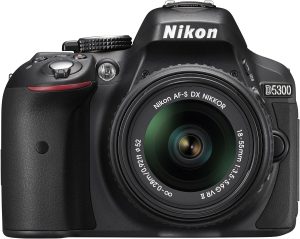Nikon D5300 24.2 MP CMOS Digital SLR Camera with 18-55mm f/3.5-5.6G ED VR Auto Focus-S DX NIKKOR Zoom Lens (Black)
With the D5300’s glorious picture quality, quick performance, and nice feature set, Nikon succeeds at improving on an already nice camera, the D5200.
As the least expensive camera, it nonetheless uses a sensor without an optical low-pass filter
(OLPF), the Nikon D5300 delivers sharper pictures than most cameras in its category. It sports an improved body style with a rather larger viewfinder and a bigger, higher-resolution LCD than its predecessor, bakes in Wi-Fi and GPS capabilities, and incorporates a stereo microphone. It uses a brand new version of Nikon’s Expeed image processor that permits the addition of 1080/60p video, an additional stop of ISO sensitivity, higher battery life (the D5300 additionally takes a brand new battery), and a few of the latest in-camera effects, toy camera, and HDR painting.
Additionally, the camera ships with a new kit lens, the 18-140mm f3.5-5.6, which provides more flexibility than the 18-105mm f3.5-5.6 that originally accompanied the D5200.
Image quality
The D5300 delivers wonderful picture quality for its value category. Although it does not have the broadest tonal range I’ve seen, it usually produces sharp photos with wonderful color copy and specialized JPEG pictures in low light; it’s pretty much as good as the Fujifilm X-M1 and arguably better as a result of the higher resolution, which gives it a lot of detail to work with. Its pictures are perceptibly better than the D5200’s at every ISO sensitivity, although it’s like that is just because they are sharper, not less noisy.
Because the sensor lacks an antialiasing filter, the pictures retain excellent sharpness even as noise rises. JPEGs look very clean up through ISO 800, and they are still quite good at ISO 1600.
Whereas ISO 3200 shows quite a bit of detail degradation, it’s still quite good in well-lit areas, and lots of my ISO 6400 shots are quite usable, even when printed to 13×19.
Whereas shooting raw is usually recommended for making subsequent exposure changes, I actually could not improve on the JPEG process and noise reduction results at any ISO sensitivity. Keep in mind
that I shoot in Fine JPEG — 1:2 compression, which is actually lossless (JPEG 1:2 uses lossless
RLE for spatial compression, however, there is continuously slight color and tonal
compression merely transcoding from the raw to the JPEG), whereas the camera defaults to 1:4 normal compression, which is unambiguously lossy. If you permit it on the defaults, your mileage might vary.
Performance
The autofocus system is unchanged; however, the D5300 bumps up to the succeeding generation of image-processing chips over the D5200; the result is similar but overall slightly better performance. Like the D5200, the slow lens driving proves to be the bottleneck in autofocus speed, even with the new 18-140mm kit lens. Even so, it’s actually quick enough for many personal or family photos.
It takes about 0.3 seconds to power on, focus, and shoot; time to refocus and shoot runs about
zero.6 seconds in each of the good and poor lighting conditions. The low-light autofocus proves to
be the foremost notable improvement over the D5200.
Pro
Excellent picture quality, a good feature set, and speedy performance place the Nikon D5300 ahead of the pack.
Con
The default settings may be better, and live view is still very slow to use.
Final Conclusion
The Nikon D5300 is a nice alternative to an all-purpose dSLR.




